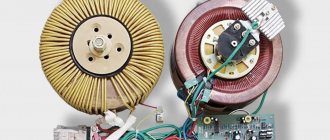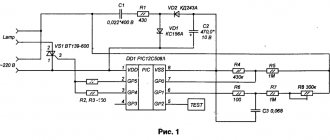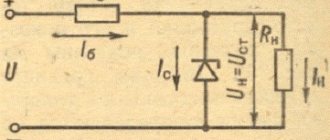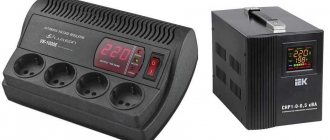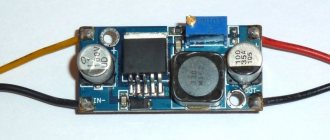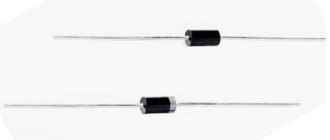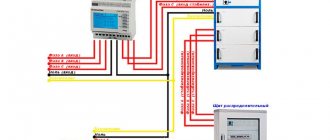Uninterrupted power supply to a private home
The popularity of private homes as permanent residences or peaceful weekend getaways is steadily growing. However, a large proportion of private development throughout the country remains autonomous in terms of the provision of public goods.
Yes, electrical networks are spread out even in the most remote corners of Russia, but the quality of power supply even within the city sometimes leaves much to be desired. But it is through electrical energy that in some houses the pumping stations of heating and water supply systems, and sometimes the heating devices themselves, operate.
In addition, unstable voltage in the power supply network can lead to failure of electrical appliances, which will entail their costly repair or even replacement. That is why homeowners often organize uninterruptible power supply systems in their private homes.
An uninterruptible power supply system (source) is a power source of electrical energy that is capable of providing continuous power supply during a short-term shutdown of the main source of electrical energy, as well as protection against voltage surges in the 220 V network for the home and power receivers connected to it.
Example of stabilizer installation
A properly selected and installed uninterruptible power supply for a private home will help you cope with a number of problems:
- prevent shutdown of the boiler system;
- prevent the pumping system from stopping;
- extend the service life of household electrical appliances;
- if you have a capacious battery, ensure uninterrupted power supply to your home not only during power surges in the network, but also during a relatively long outage of the electricity supply system.
In what cases will the use of electromechanics still be appropriate?
The use of servo drive devices seems quite justified in everyday life at low consumption loads in networks with small voltage drops.
Many users, especially those who have dachas, are probably well aware of the state of rural, dacha or even urban power grids in the private residential sector and in practice have more than once encountered poor-quality power supply. Therefore, the use of electromechanics is in great demand in everyday life - as a relatively effective and inexpensive solution.
Considering the nature of the connected load, we can safely recommend them for stabilizing the output voltage in lighting networks. The smoothness of stabilization completely eliminates or partially smoothes out changes in mains voltage, making jumps in light emitted by lamps less noticeable and irritating to the eyes. To be fair, we note that this only applies to lamps with incandescent and halogen lamps. Of course, there will be no such effect with gas-discharge lighting devices that work with ballasts, or with LED lamps that are becoming increasingly popular.
Methods to protect your home electrical network from overvoltage
There are other ways to protect the network and electrical appliances included in it from power surges. Let's take a closer look at their features and differences.
Relay protection
Surge protection relay is a device designed to interrupt the supply of electrical energy during any surge or drop in voltage.
The main advantage of a voltage relay is its speed. The response time of modern protective relays is measured in tens of nanoseconds. Protecting the electrical network from overvoltage using relays is very effective in emergency situations that arise as a result of a neutral line break, overload, phase imbalance and other similar incidents.
Network filters
A network filter (or varistor) is a device based on semiconductors to protect the network and power receivers included in it from voltage surges by suppressing impulse noise.
Voltage control
When the voltage drops in the network, the varistor acts as a high-resistance element, a resistor, without passing electric current. When the voltage increases to the nominal value, the resistance of the semiconductor decreases and the electric current again passes through the network filter.
It should be noted that surge protectors can only cope with small short-term impulse noise. However, they are widely used when connecting computers, their peripheral devices and other office equipment to the electrical network.
Surge Protectors
Voltage stabilizer is a device designed to maintain the voltage of the consumer’s home electrical network at values close to the nominal value, in the event of a significant change in the voltage of the power supply network.
In other words, a 220 V voltage stabilizer for the home allows you to normalize the power supply and maintain the serviceability of the switched-on power receivers even with large voltage drops in the electrical network.
Important! When choosing a voltage relay, voltage stabilizer or surge protector, you should take into account both the operating principle of each specific device and its cost.
Relays and filters that protect against voltage surges will cost much less than high-quality stabilizers. However, unlike a stabilizer, a voltage relay is not capable of equalizing the voltage in the network; it simply turns off the protected section when the voltage rises or falls and automatically turns it on when the voltage in the network stabilizes, and varistor filters cannot cope with serious voltage fluctuations.
Diagram for connecting the stabilizer to a 220V network
Tips for choosing a stabilizer
When choosing, consider the following factors:
- Stabilizer model based on the number of network phases. If 1-phase devices operate in your three-phase network, then to protect against voltage surges it is better to use three separate single-phase stabilizers.
- Device power. When determining this parameter, you need to take into account that some devices have asynchronous motors, which have high starting currents.
- Precision stabilization to protect household devices, its performance.
- Availability of auxiliary functions.
- Operating conditions of the device.
- When choosing a device, it is necessary to take into account the wiring diagram of the power circuit.
Comparison of relay and thyristor stabilizer
Classification of stabilizers
These, the most effective to date, voltage surge compensation devices are usually divided into 5 types:
- relay;
- electronic;
- electromechanical;
- ferroresonant;
- inverter
Each type of stabilizer has its own advantages and disadvantages, which should be taken into account when deciding how to choose a 220 V voltage stabilizer for your home.
Relay voltage stabilizers
Relay voltage stabilizers operate according to the principle of relay protection described above, but the multi-stage nature of the device makes it possible not to break the electrical circuit.
This type of stabilizer device is considered the most popular for private residential buildings, which is obviously due to its relatively low cost, as well as its compact design.
The main disadvantages of relay stabilizers are:
- step change in voltage;
- voltage sine wave distortion;
- output power limitation;
- low quality and accuracy of voltage regulation;
- noise when switching the internal relay.
Important! Overloading of this type of stabilizers is the most common cause of their failure.
Relay stabilizer
Electronic voltage stabilizers
Electronic 220 V voltage stabilizers for the home are also stepped, but the voltage regulation, in this case, is carried out more smoothly.
In addition, unlike their counterparts that operate on the principle of relay protection, they operate almost silently, which allows them to be installed in rooms where people are constantly present. In addition, electronic stabilizers have high efficiency and respond quickly in the event of voltage surges.
This type of stabilizers is less susceptible to overloads. They calmly cope with starting currents on pumping motors and other similar devices. Another advantage of electronic stabilizers is their resistance to low temperatures, therefore, they can be installed in unheated rooms.
The cost of these devices is, accordingly, higher than that of relay ones.
Electromechanical voltage stabilizers
Electromechanical stabilizers are also called servo-drive or servomotor. They represent a kind of golden mean between relay and electronic stabilizers. The servo drive at the heart of such transformers is a stepless regulator operating on the principle of a rheostat.
Electromechanical stabilizer
Due to their design, electromechanical stabilizers have the following advantages:
- smooth adjustment;
- high accuracy;
- no voltage sinusoid distortion;
- resistance to short-term overloads;
- relatively low cost;
- compact sizes.
However, these models of stabilizers are characterized by low response speed, noisy operation and “heat-loving behavior”.
Ferroresonant voltage stabilizers
This type of transformer was popular among the population about 30 years ago, when tube TVs were connected to the power supply through it. Nowadays, they have given way to more modern models, which, in addition to those listed, include inverter voltage stabilizers.
Inverter voltage stabilizers
The principle of operation of the inverter stabilizer is to convert the alternating current coming from the supply network at the input and convert it back at the output of the stabilizer.
Inverter stabilizers
This is the most expensive type of stabilizer, which at the same time has a number of significant advantages:
- wide operating range;
- high accuracy;
- compactness;
- performance;
- frost resistance;
- long service life;
- noiselessness.
Electromechanical stabilizer and its advantages
If you are planning to use this device, then you need to remember that its main advantages include:
- Fairly low price.
- High stabilization accuracy.
- Smooth adjustment of output voltage.
Now we need to look at each benefit in more detail. Thanks to this, you can accurately put together the overall picture. If you are interested, then read about a do-it-yourself voltage stabilizer.
Low price
If you plan to use a vintage device, then the cost will be minimal. Modern electromechanical stabilizers have servomotors and high-precision mechanisms. If the device contains these elements, then its price will increase significantly.
Electromechanical stabilizers differ significantly from a relay device. It uses moving elements that can break down over time. If you do not have the necessary experience, then you need to hire a specialist who can fix this breakdown.
Stabilization accuracy
This device is highly accurate. Its indicators are around 2-3%. This indicator is considered stable. That is why you should pay attention to it when choosing. The device is also perfect for high-precision equipment.
Smooth adjustment
This benefit may be required if you have precision equipment connected to your device. Thanks to this function, you can independently adjust the smoothness of transitions. For household appliances, it is best to use other types of stabilizers, as they can quickly switch voltage.
The best voltage stabilizers for a private home
This rating of voltage stabilizers for the home is based on a sample of devices designed for power from 10 to 20 kW, which is considered optimal for the average country house.
RUCELF STAR-12000
This is a rheostatic stabilizer with a permissible power of 12 kW, which has a solid efficiency of 98% and stabilization accuracy (error) of 6%. It will protect your home network from short circuits, overheating and overvoltage.
RESANTA LUX ASN-10000N/1-C
Another rheostatic stabilizer, the characteristics of which are slightly worse than the previous one. With an active power of 10 kW, the efficiency of RESANT LUX ASN-10000N/1-Ts is 97%, and the stabilization error is 8%. But this stabilizer will protect the network not only from short circuits, from overheating and from high voltage, but also from interference, and also has an optimal price-quality ratio.
Resanta ASN-1000 N/1-C Lux 63-6-14
Energy ASN 20000
This stabilizer is also rheostatic and is designed for a power of 20 kW. Stabilization accuracy and efficiency, like RUCELF StaP-12000, are 6% and 98%, respectively. It protects the electrical network and electrical appliances included in it from short circuits, overheating, overvoltage and interference.
Volter SNPTO-11 PTTSH
This stabilizer is electronic. Its active power is 11 kW, and its efficiency is 98%. Volter SNPTO-11 PTTSh operates at temperatures from -40 to +40 degrees Celsius and protects the network from short circuits, overheating, overvoltage, and interference.
Lider PS10000W-50
Another stabilizer, which is electronic. Its power is 10 kW, efficiency is 97%, stabilization error is 4.5%. It protects the electrical network from short circuits, overheating, overvoltage and interference. The main advantage of this model is its very wide input voltage range: from 110 to 380 V.
Device
Digital voltage stabilizer
A single-phase electromechanical voltage stabilizer consists of the following components:
- The actual autotransformer;
- Brush unit;
- Servo;
- Monitoring and control unit;
- Display block;
- Internal power supply device;
- Protection device.
As an additional option, manufacturers may also include filter elements to protect consumers from interference traveling through the AC power supply.
Autotransformer
This is the largest and heaviest unit. The power of the autotransformer determines the size of the load, which can reach tens of kilowatts. The advantage of an autotransformer is that it does not have separate primary and secondary windings. The secondary winding is part of the primary. When the input and output voltages are equal, the transformer does not play any role, only adding load to the network in the form of an insignificant no-load current.
Brush unit
Thanks to the brushes, contact is formed with the turns of the transformer winding. The requirements for the brush assembly are low friction to facilitate movement along the winding, low contact resistance and resistance to wear.
Brushes are the most unreliable element of a servo voltage stabilizer. The service life of current-collecting elements, even with moderate use, is several years, after which they must be replaced.
Brush unit
Graphite-based material is used to make brushes. The properties of graphite are its low coefficient of friction and low electrical resistance. At the same time, graphite is a rather soft material, and brushes wear out over time. To ensure uniform production and reduce wear, brushes are often made in the form of wheels that roll along the turns of the autotransformer.
The presence of transition resistance between the brush material and the turns of the transformer causes increased heat generation at the point of contact. The resistance is especially high in those parts of the winding where the brushes are infrequent, for example, with a large decrease or increase in the input voltage, since the bare turns of copper wire are covered with a film of oxides from contact with air.
To remove excess heat, the brush assembly is equipped with a finned cooling radiator.
Servo
The stepper motor that is used to drive the brush assembly must have a high rotation speed and power sufficient to overcome the frictional force of the brushes pressed by springs to the winding. Of course, the higher the power of the stabilizer, the larger the brushes and the higher their friction against the windings. Accordingly, the power of the servo drive should also be higher.
Servo
Electronics blocks
The electronic control unit controls the values of the input and output voltages. The greater the mismatch, the greater the number of pulses that must be applied to the winding of the stepper motor. As the brush assembly rotates, the output voltage gets closer and closer to the nominal value. If there is an exact match, the supply of control pulses stops completely.
The display unit allows you to visually monitor the status of the input and output voltages. Data is displayed on a digital indicator or pointer device in cheap models.
The protection device disconnects the device from the network and the load when the voltage goes beyond the permissible values, as well as when the permissible load of consumers is exceeded.
To power the internal electronic circuit, a small-sized, low-power transformer is used, the primary winding of which is designed for the entire permissible input voltage range.
Internal organization
Connecting a voltage stabilizer for the home
The connection diagram for a voltage stabilizer in a private house, although it requires compliance with basic safety rules, is quite primitive. Therefore, it will not be difficult for you to do such work as connecting a voltage stabilizer to your home network.
This device is usually mounted at the entrance to the house, directly after the electric meter . This ensures that it responds as quickly as possible when distortion occurs. There should be an automatic switch in front of the stabilizer, which can be used to de-energize the stabilizer if necessary.
Also, the installation site of the stabilizer simply must be dry, dust-free and well ventilated in order to protect the structure from moisture, dust and overheating.
Upon completion of the work, it is necessary to carefully check the correctness and reliability of all connections made, and then apply voltage.
Life in your own country house is not only peace and harmony with the outside world. It is also constant work. And in order for this work to be a joy, it is necessary to protect yourself as much as possible from any troubles in the public sector. Now you know how to solve one of these problems and ensure high-quality power supply to your home.
Single- or two-phase EMC
Triac voltage stabilizer
Electromechanical stabilizers are mainly used to regulate the voltage of single-phase current. The devices are used in homes, offices and where electrical equipment connected to a 220-volt household power supply is used.
Two-phase stabilizers are installed in those rooms where it is necessary to connect powerful consumers. For example, two-phase EMC is used to power electric welding equipment, machine tools and other installations.
Electromechanical
Electromechanical SVs are also commonly called servomotor or servo-drive. Such stabilizers operate by moving a carbon electrode along the windings of an autotransformer thanks to an electric drive. Electromechanical devices can also be used to protect household appliances in the house, apartment and country house. The advantage of this type of stabilizer is its low cost, smooth voltage regulation and compact size. The disadvantages include increased noise during operation and low performance.
How to choose equipment: key characteristics
Almost all types of stabilizers are suitable for household use. To finally determine which voltage stabilizer to choose for a private home, country house or cottage, you need to know the key characteristics of the devices and their compliance with specific needs.
Phasing
Stabilizers are single-phase and three-phase. Conventional household appliances operate on a single-phase 220 V network. In some cases, a 3x380 V network is required to power electric ovens, pumps or welding machines. For a home where the use of such equipment is not intended, a single-phase 220 V stabilizer is suitable.
Power
When choosing a stabilizer, you should take into account the total power of the devices connected to it. Typically, the total power is indicated in the product data sheet. We must not forget that devices with an electric motor, at the moment of startup, consume an amount of energy several times greater than their rated power. Therefore, the total permissible power for the stabilizer must exceed the total by 3–5 times, otherwise, when the equipment is turned on, the protection will be triggered every time.
When choosing power, it is necessary to take into account the nature of the load.
Active load
Devices that convert electrical energy into lighting and heat, such as all incandescent lamps, irons, electric stoves, heaters, are devices with active loads. The unit of measurement for active load is kW; when choosing a stabilizer for such devices, correction factors are not required. If the total active power is 1 kW, then it will be enough to install a stabilizer with a similar power.
Reactive load
So-called reactive power is consumed by capacitive or inductive devices, such as electric motors or devices with capacitor banks. The total power of such devices consists of active and reactive and is measured in kVA.
When choosing a stabilizer for devices of this type, the active power is separated from the total power by multiplying the total power in kVA by the cosine phi value indicated in the device passport. If this indicator is not specified, then its average value is taken as 0.7.
Power reserve
To increase the service life of the stabilizer, it is advisable to provide a power reserve of about 20%. The operating mode of the device will be more gentle, and if necessary, additional devices can be connected to it.
Stabilized voltage range
All stabilizers indicate the operating voltage range. The operating range is the input voltage value at which the stabilizer is able to adjust the output voltage. If the input voltage exceeds this value, the stabilizer will turn off all devices. The usual operating range for stabilizers used for private homes and cottages is 130–270 V.
To determine the required operating range of a household voltage stabilizer for a summer house or home, you need to carry out control measurements of the incoming voltage in the network for several days. It is advisable to do this in the morning and evening, when the load on the network is especially high, making sure to turn on the maximum number of consumer devices. The extreme values obtained from the measurement results will be the recommended operating range of the stabilizer.
It is necessary to take into account that, in fact, the stabilizer has two ranges. The first type - the input voltage is within the limits at which the output voltage is 220 V plus or minus 5%. The second type is extreme range, which occurs when the input voltage changes significantly and the output voltage changes within 15-18%. This range is the last step before turning off all devices. It is harmful for the stabilizer to work in this mode for a long time, but with short-term changes this is quite acceptable.
Stabilization accuracy
The stabilization accuracy is understood as the maximum difference in the lower or higher side of the output voltage from the nominal value. The stabilization accuracy of the selected device cannot be less than the requirements for the supply voltage of each of the devices connected to it. If these devices have different voltage requirements, then it is necessary to take the minimum value as a basis or connect the equipment to different stabilizers. Most household electrical appliances can operate with a stabilization accuracy of 220 V ± 5–7%. However, lighting devices require an accuracy of no more than 3%, since insufficient accuracy of the output voltage leads to changes in lighting intensity in the event of differences in the input network.
Installation method
According to the installation method, all stabilizers are divided into wall and floor. When choosing a location, we must not forget that the stabilizer heats up during operation and its fans must be able to operate freely. Humidity, dust, high or low temperature have a harmful effect on the stabilizer. Do not install it in damp basements or attics.
The optimal place to install a main voltage stabilizer for a summer house or home will be a point next to the distribution panel in the corridor or dry storage room.
Availability of information display
Some models of stabilizers are equipped with an information display that records all operating indicators: input and output voltage, load value, message about an accident and the reasons for its occurrence (in the stabilizer, in the network, in the load).
In order not to overload the stabilizer, it is recommended to connect only those devices whose operation actually requires constant voltage values:
- TV;
- computers and office equipment;
- communication devices;
- fridge;
- lighting.
It is not advisable to connect household heating devices equipped with heating elements to the stabilizer, since they can also operate at unstable voltage. The same applies to devices with high starting currents (pumps, welding machines), which, when turned on, can trigger the protection in the stabilizer and de-energize the entire network.
Relay
Relay stabilizers, or step stabilizers as they are also called, are considered the most popular for use in the home and country house. This is due to the low cost of the devices, as well as high control accuracy. The principle of operation of the relay model is to switch windings on a transformer using a power relay, which operates automatically. The main disadvantages of this type of MV are considered to be a step change in voltage (not smooth), sinusoid distortion and limited output power. However, judging by reviews on the Internet, most buyers are satisfied with the devices, because the price is several times less than more advanced models. A representative of relay-type stabilizers for the home is Resanta ASN-5000N/1-C, which you can see in the picture below:
The best stabilizer manufacturers
The production of devices that stabilize the power supply of the network (domestic or industrial) is established at a wide level. In any case, it is not difficult to find a dozen well-known companies, especially if the property owner is faced with choosing a voltage stabilizer for a summer cottage or country house.
Let's see which companies attract the most attention and how much this attention is justified by practice.
Place #1 -
Pskovskaya is a truly attractive supplier of stabilizing modules, given the company’s long history and accumulated experience.
However, Russian production of electrical components has been valued at all times, excluding the current time. Only in comparison can true quality be known, and such a comparison has been tested in practice over the 15-20 years since the appearance of foreign products on the market.
Stabilizing modules are produced in a wide range, ranging from low-power 400-watt devices to equipment where power is measured in kilowatts
However, the modern one assembles voltage stabilizers from American parts. In particular, thyristors of the IXYS series, as well as microprocessor control modules, are used to construct the device circuit.
The company's popular product is the LIDER series . For example, model PS5000SQ , designed for power consumption up to 5 kW. Quite a good option for installation in a country house.
Place #2 - Resanta enterprise
This foreign manufacturer, judging by the reviews of the owners, offers relatively high-quality equipment. The operating principle of which, as in the first case, is based on electronic control of the stabilization process.
The basis of the product is voltage stabilizers up to 5 kW, suitable for installation in country real estate (dacha).
Compact and convenient for use in the country - voltage stabilizers from are in fairly high demand in the commercial market
Specifically, we can note the model ASN-5000/1-EM , which, according to the manufacturer’s characteristics, demonstrates a high efficiency in stabilizing the network electrical potential.
Installing such equipment at the same dacha provides the user, among other things, with additional functions:
- protection against short circuit (short circuit);
- preventing overheating of load lines;
- elimination of overvoltage;
- bypass functions.
The device connection instructions provide for the use of direct power input.
Place #3 - electrical engineering
The products of this manufacturer, designed for installation in everyday life, including summer cottages, are mostly represented by electromechanical voltage stabilizers.
A wide range of 5-kilowatt devices are offered, designed to stabilize input voltages in the range of 130-255 volts.
The configuration of the devices allows for installation of devices on the wall or floor. Despite the electromechanical design, the equipment creates virtually no noise during operation.
The control system allows you to configure some parameters manually. Relatively inexpensive product.
One of the models produced by . At the same time, the company produces a wide range of similar equipment, including those well suited for country house installation
Energia products have a significant price range. Thus, one of the models of this manufacturer, marked with the ASN 2000 , can be purchased for only 3,500 rubles.
True, a power of 1.5 kW in other cases may not be enough. Then there is another option - Hybrid 5000 , priced at 15 thousand rubles, which provides power up to 5 kW.
Place #4 - Elektromash enterprise
The Tula enterprise produces stabilizing modules under the RUSELT . Design features of the products are inverter type devices.
Such equipment is characterized by a high degree of sensitivity to voltage changes. Accordingly, the level of equipment stabilization is characterized by small errors, according to the characteristics - no more than 1%.
Voltage stabilizers produced by the Elektromash industrial group. Powerful electrical installations, often combined with an uninterruptible power supply
Systems of this type, of course, are more expensive. Thus, a popular product, the RUSELT SDP-1/1-10 , is estimated by the commercial market in the range of 60-65 thousand rubles.
The device provides a high degree of reliability along with good parameters, therefore it is often used for networks of important objects, for example, healthcare facilities.
Place #5 -
Another Tula company is a direct competitor of Elektromash JSC, given the supply of equally attractive stabilization systems to the commercial market. characterized by a wide-profile production of electrical equipment.
The company's products are not limited to voltage stabilizers for cottages and houses. In addition, the production of other products has been launched, for example, uninterruptible power supplies.
The product is characterized not only by a successful design, but also by high technical and operational parameters, in particular, high power. However, the range is varied
Among the range of voltage stabilizers, it is worth considering a model called “InStab” IS1110RT - the best option for a summer house and a large country house.
The device is quite powerful - up to 8 kW, characterized by high efficiency (97%) and a low level of stabilization error (no more than 2%). In addition, there is another choice from dealer equipment catalogs.
The list of stabilizer manufacturers goes on - there are many worthy brands on the market specializing in the production of electrical equipment.
But, in addition to the company’s reputation, the potential owner also needs criteria that will help him choose a high-quality stabilizer. Therefore, in addition to a brief overview of manufacturers, we will consider an important point in choosing such systems.
An overview of the ten best models of stabilizers for the home with a description of their characteristics, as well as user reviews, is given in this article.
Types of modern stabilizers
There are various types of stabilizers, differing in design and principle of operation, which it is advisable to familiarize yourself with before choosing a device. The main types of stabilizers currently on the market include the following types:
- electromechanical and electrodynamic devices using a servo drive;
- relay;
- electronic (thyristor and triac);
- hybrid;
- inverter
The principle of operation of stabilizers.
The operating principle of the first three types is based on the method of changing the transformation ratio of the autotransformer.
Note.
An autotransformer is a type of transformer in which there is only one winding, different numbers of turns of which serve as the primary and secondary windings.


